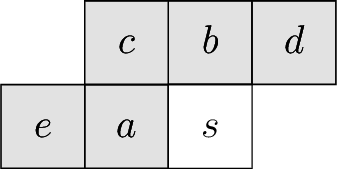- Let Q the actual context (there are 1094 different spatial contexts).
- Let N[Q] the number of times that the context Q has been found.
- Let B[Q] the accumulated prediction error for the context Q.
- Let A[Q the sumatory of the absolute value of the prediction residues for the context Q.
- Let C[Q] the the bias cancellation values for the context Q. These values are added to the predictions to try that the predictions residues have a zero average. If this is not satisfied, the compression ratio in reduced severelly because the average of the real Lapace probability distribution of the residues and the modeled probability distribution does not match. For this reason, C[Q] is proportional to B[Q]∕N[Q] that added to the predictions, cancel the bias.
 :
:
- Compute the local gradient:


- Quantize the gradients:

for i = 1,2,3 and

- The initial prediction:

- Bias cancellation:
![{ ˆs+ C [Q ] if g1 > 0
ˆs ← ˆs− C [Q ] otherwise.](index4x.png)
- Compute the prediction error:

where β is the number of bits/pixel. This produces a projection of the residues from the dynamic range [−α + 1,α− 1] to [−α∕2,α∕2 − 1], where α = 2β is the size of the source alphabet.
- Shuffle the residues in order to get an exponiential (with negative
exponent) distribution of the probability of the residues:

After that, the residues are in the range [0,1,
 ,2β − 1]
,2β − 1]
- Output ← a Rice code for M(e) using the slope k = ⌈log 2(A[Q])⌉.
- B[Q] ← B[Q] + e.
- A[Q] ← A[Q] + |e|.
- If N[Q] = RESET, then: (where 64 ≤ RESET ≤ 256)
- A[Q] ← A[Q]∕2.
- B[Q] ← B[Q]∕2.
- H[Q] ← N[Q]∕2.
- N[Q] ← N[Q] + 1.
- Update of C[Q]:
- If B[A] ≤−N[Q], then:
- B[Q] ← B[Q] + N[Q].
- If C[Q] > −128, then:
- C[Q] ← C[Q] − 1.
- If B[Q] ≤−N[Q], then:
- B[Q] ←−N[Q] + 1.
- Else:
- If B[Q] > 0, then:
- B[Q] ← B[Q] − N[Q].
- If C[Q] < 127, then:
- C[Q] ← C[Q] + 1.
- If B[Q] > 0, then:
- B[Q] ← 0.
- If B[Q] > 0, then:
- If B[A] ≤−N[Q], then:
![{ ˆs− C [Q ] if g > 0
ˆs ← ˆs+ C [Q ] oth1erwise.](index8x.png)
